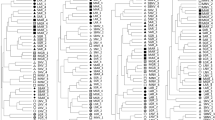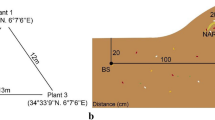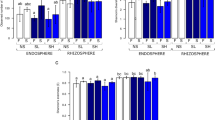Abstract
Acid sulfate soil is generated by chemical and microbial oxidization of sulfide-rich minerals/sediments. Although revegetation of the soil is difficult due to low-pH and poor nutrient availability, pioneer plants may adapt to such an extreme environment via associating with mycorrhizal fungi and/or N-fixing bacteria for acquisition of mineral nutrients. In this study, an abandoned quarry in which acid sulfate soil was found was chosen to investigate the influence of soil acidity on the levels of colonization by the microsymbionts, the identities of the microsymbionts that associated with pioneer plants and the dependency of pioneer plants on the microsymbionts. The levels of arbuscular mycorrhizal (AM) colonization in pioneer grass, forbs and legume shrubs grown in the field were assessed, and no significant decline in the levels with an increase in soil acidity was observed. Most of the legume shrubs formed root nodules. Several AM fungi and bradyrhizobia were cultured from the rhizosphere soils of pioneer plants grown in the quarry and identified based on the sequences of the small subunit ribosomal RNA genes. Pot experiments revealed that the microsymbionts isolated from the field significantly promoted the growths of pioneer grasses and legume shrubs in acid sulfate soil at pH 3.4. These results suggest that plant–microbial symbiotic associations play significant roles in the growth of pioneer plants in acid sulfate soil.






Similar content being viewed by others
References
Allen MF (1987) Re-establishment of mycorrhizas on Mount St Helens Washington USA migration vectors. Trans Brit Mycol Soc 88:413–417
Allen MF (1991) The ecology of mycorrhizae. Cambridge University Press, Cambridge, NY, USA, pp 127–140
An G-H, Miyakawa S, Kawahara A, Osaki M, Ezawa T (2008) Community structures of arbuscular mycorrhizal fungi associated with pioneer grass species Miscanthus sinensis in acid sulfate soils: habitat segregation along pH gradients. Soil Sci Plant Nutri (in press) DOI 10.1111/j.1747-0765.2008.00267.x
Appleyard S, Wong S, Willis-Jones B, Angeloni J, Watkins R (2004) Groundwater acidification caused by urban development in Perth, Western Australia: source, distribution, and implications for management. Aust J Soil Res 42:579–585
Barea JM, Azcon R, Azconaguilar C (1992) Vesicular-arbuscular mycorrhizal fungi in nitrogen-fixing systems. Meth Microbiol 24:391–416
Bohlool BB, Ladha JK, Garrity DP, George T (1992) Biological nitrogen-fixation for sustainable agriculture – a perspective. Plant Soil 141:1–11
Brundrett MC, Abbott LK, Jasper DA (1999) Glomalean mycorrhizal fungi from tropical Australia I. Comparison of the effectiveness and specificity of different isolation procedures. Mycorrhiza 8:305–314
Cline GR, Senwo ZN (1993) Inhibitory effects of acidic minesoil on the Sericea lespedeza/Bradyrhizobium symbiotic relationship. J Plant Nutri 16:1867–1880
Cline GR, Senwo ZN (1994) Tolerance of lespedeza Bradyrhizobium to acidity, aluminum, and manganese in culture media containing glutamate or ammonium. Soil Biol Biochem 26:1067–1072
Cline GR, Silvernail AF (1997) Effects of soil acidity on the growth of sericea lespedeza. J Plant Nutri 20:1657–1666
Do TTR, Tinh TK, Nguyen TNM, Linh TB (2004) Applying mixed manure and inorganic phosphorus fertiliser to improve rice yield on acid sulfate soil (Hydraquentic Sulfaquept). Aust J Soil Res 42:693–698
Giovannetti M, Mosse B (1980) An evalu`tion of techniques for measuring vesicular-arbuscular mycorrhizal infection in roots. New Phytol 84:489–500
Herrera MA, Salamanca CP, Barea JM (1993) Inoculation of woody legumes with selected arbuscular mycorrhizal fungi and rhizobia to recover desertified Mediterranean ecosystems. Appl Environ Microbiol 59:129–133
Jansa J, Smith FA, Smith SE (2008) Are there benefits of simultaneous root colonization by different arbuscular mycorrhizal fungi? New Phytol 177:779–789
Johnson NC, Wolf J, Reyes MA, Panter A, Koch GW, Redman A (2005) Species of plants and associated arbuscular mycorrhizal fungi mediate mycorrhizal responses to CO2 enrichment. Global Change Biol 11:1156–1166
Kayama M (2001) Comparison of the aluminum tolerance of Miscanthus sinensis Anderss. and Miscanthus sacchariflorus Bentham in hydroculture. Int J Plant Sci 162:1025–1031
Larson JL, Siemann E (1998) Legumes may be symbiont-limited during old-field succession. American Midland Naturalist 140:90–95
Nara K, Hogetsu T (2004) Ectomycorrhizal fungi on established shrubs facilitate subsequent seedling establishment of successional plant species. Ecology 85:1700–1707
Oba H, Shinozaki N, Oyaizu H, Tawaraya K, Wagatsuma T, Barraquio WL, Saito M (2004) Arbuscular mycorrhizal fungal communities associated with some pioneer plants in the Lahar area of Mt. Pinatubo, Philippines. Soil Sci Plant Nutri 50:1195–1203
Porter WM, Robson AD, Abbott LK (1987) Factors controlling the distribution of vesicular-arbuscular mycorrhizal fungi in relation to soil pH. J Appl Ecol 24:663–672
Powell B, Martens M (2005) A review of acid sulfate soil impacts, actions and policies that impact on water quality in Great Barrier Reef catchments, including a case study on remediation at East Trinity. Mar Poll Bull 51:149–164
Requena N, Jimenez I, Toro M, Barea JM (1997) Interactions between plant-growth-promoting rhizobacteria (PGPR), arbuscular mycorrhizal fungi and Rhizobium spp. in the rhizosphere of Anthyllis cytisoides, a model legume for revegetation in mediterranean semi-arid ecosystems. New Phytol 136:667–677
Requena N, Perez-Solis E, Azcon-Aguilar C, Jeffries P, Barea J-M (2001) Management of indigenous plant-microbe symbioses aids restoration of desertified ecosystems. Appl Environ Microbiol 67:495–498
Richardson AE, Simpson RJ (1989) Acid-Tolerance and symbiotic effectiveness of rhizobium-trifolii associated with a Trifolium-Subterraneum L-based pasture growing in an acid soil. Soil Biol Biochem 21:87–95
Smith SE, Read DJ (1997) Mycorrhizal symbiosis. Academic, San Diego, CA, p 605
Truog E (1930) The determination of the readily available phosphorus of soils. J Am Soc Agron 22:874–882
van Aarle IM, Soderstrom B, Olsson PA (2003) Growth and interactions of arbuscular mycorrhizal fungi in soils from limestone and acid rock habitats. Soil Biol Biochem 35:1557–1564
Warner NJ, Allen MF, Macmahon JA (1987) Dispersal agents of vesicular-arbuscular mycorrhizal fungi in a disturbed arid ecosystem. Mycologia 79:721–730
White TJ, Bruns T, Lee S, Taylor J (1990) Amplification and direct sequencing of fungal ribosomal RNA genes for phylogenetics. In: Innis MA, Gelfand DH, Sninsky JJ, White TJ (eds) PCR protocols: a guide to methods and applications. Academic Press, San Diego, pp 315–322
Wilson D (1988) Differential plant response to inoculation with two VA mycorrhizal fungi isolated from a low-pH soil. Plant Soil 110:69–75
Wilson GWT, Hartnett DC (1998) Interspecific variation in plant responses to mycorrhizal colonization in tallgrass prairie. Am J Bot 85:1732–1738
Yao ZY, Kan FL, Wang ET, Wei GH, Chen WX (2002) Characterization of rhizobia that nodulate legume species of the genus Lespedeza and description of Bradyrhizobium yuanmingense sp. nov. Int J Syst Evol Microbiol 52:2219–2230
Acknowledgements
We are grateful to Drs. I. Nioh, K. Saito, M. Satio, M. Abe and Y. Hashimoto for invaluable suggestions, to M. Maesaka, S. Mizuno and Y. Tahara in Nagoya University for technical assistance and to Aichi prefecture for allowing us to collect the samples from the field. This study was supported by Tokai Gakujutsu Shoreikai and the Japan Society for the Promotion of Science (TE).
Author information
Authors and Affiliations
Corresponding author
Additional information
Responsible Editor: F. Andrew Smith.
Rights and permissions
About this article
Cite this article
Maki, T., Nomachi, M., Yoshida, S. et al. Plant symbiotic microorganisms in acid sulfate soil: significance in the growth of pioneer plants. Plant Soil 310, 55–65 (2008). https://doi.org/10.1007/s11104-008-9628-y
Received:
Accepted:
Published:
Issue Date:
DOI: https://doi.org/10.1007/s11104-008-9628-y




